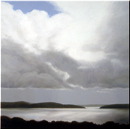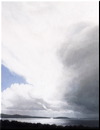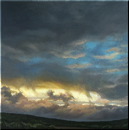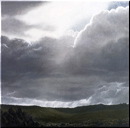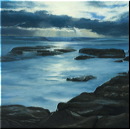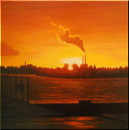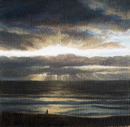|
|
|
|
JILL KEMPSON ::: SKYSCAPES ::: GALERIE DÜSSELDORF ::: 18 November - 16 December 2007
| |
|
| |
|
Rick Spencer : The West Australian 30/11/2007
Two artists delving back into the history of landscape are showing at Galerie Düsseldorf. Frank Morris' Chiming Wedgebill and Jill Kempson's Skyscapes are, like Holly Grace's glass work (see above), equally engaged in how we sense the landscape. I
say sense because Kempson has, very bravely I think, gone back into
the academic history of landscape painting in almost an ode to the genre.
Morris on the other hand is questioning the dominance of the gaze and
wondering if there aren't other ways to sense the world around us. We can then critique Kempson's timeless landscapes by using traditional methods of Australian criticism and writing of her work as an attempt to find a place in the Australian landscape and a place in the history of Australian landscape painting. That's probably unfair too. I found Kempson's Waychinicup and Wilson Inlet series strangely intoxicating to stand and view; they suggest stillness and tranquillity but are equally full of the painter's presence and all her skills of composing observation. In this sense they are, for me, all about owning a moment in time but with the added layer of anxiety that comes from the impossibility of being around for ever. This is something most artists deal with on a day-to-day basis. Equally aware of the history of Australian landscape painting is Frank Morris' Chiming Wedgebill. His last solo at Galerie Düsseldorf was titled Onomatopoeia, whereby the sounds literally make the meaning in such words as buzz or crash, and this gives us an insight into the immediate way Morris attempts to articulate his world. The micro / macro aspect to the works in this show illustrates well the impact of understanding or rather being immediately within your surroundings. It's taking that moment to realise where you are and how you got there and this impact can often bring the micro up to macro scale. I really enjoyed the way Morris has gone about his work in Chiming Wedgebill. His translation of the simple gum tree, as seen in Catalogue No.2, Three Cuts and a Fold is sensational on a number of levels. Try holding this image together visually as you stand in front of it. Chiming Wedgebill is a move on from sound to the sense of taste. I don't think Morris' work is coincidentally similar to the aesthetic of Claes Oldenburg's fast food series. His small scientific description of the Chiming Wedgebill as having a voice of a descending chime - "Why did you get drunk" - and his tongue series, particularly No.5, gives some idea of the oral tactility of viewing that Morris is trying to bring to this series of works. Those of you who've had camel mouth from the night before might understand this better then others. As
we know from babies, putting everything in your mouth is one way of
seeing the world.
Chiming Wedgebill and Skyscapes at Galerie Dusseldorf until December 16.
Jill
Kempson Jill
Kempson Frank
Morris Frank
Morris |

